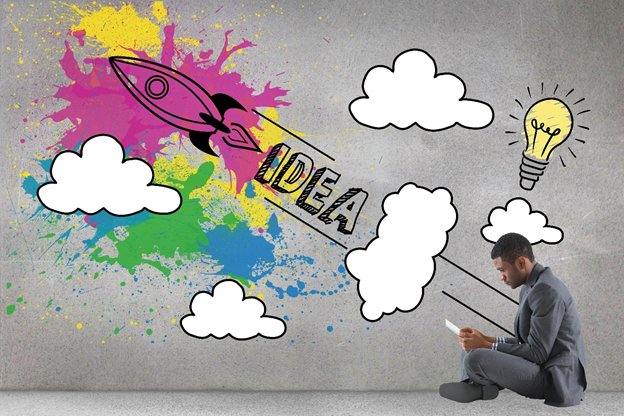Design Thinking: think outside the box
It is easy to say that thinking outside the box allows us to solve complex problems innovatively, but putting it into practice can be a big challenge...
Do you know what the world's largest media and entertainment conglomerate, aka Disney, digital accommodation platform Airbnb, management systems giant SAP and Apple have in common?
All use Design Thinking.
Index
What is Design Thinking and where does it come from?
Design Thinking is a methodology that facilitates the solution of complex problems, using creativity and design tools as drivers of innovation. In recent years, this methodology has become a trend on the internet, however, its origins are not so new.
A very important figure is John Arnold, psychologist and mechanical engineer, who in the mid-1950s held a summer programme at MIT, where "Buckminister Fuller with his concept of scientific design, the brainstorming technique of Alex Osborn and W.J. Gordon with the methodology called Operational Creativity, where he spoke of his theory of synectics and what we know today as insights" (Saavedra, 2021). It was through this programme that John Arnold understood the need to improve technical capabilities in aspects such as creativity and engineering.
From there, the design process began to evolve into a holistic methodology, which considered creativity and analysis, thus no longer just about product creation, but also drawing the attention of strategists.
Read more: Design Thinking Tools
Shortly afterwards, John Arnold arrived at Stanford University, where he founded the Design Division of the Department of Mechanical Engineering and was supported by Bob McKim, who is credited with people-centred design, an important element of Design Thinking.
At Stanford the methodology was developed theoretically, but the impulse to practice and dissemination was given by the IDEO team.

What is Design Thinking for?
As I already mentioned, Design Thinking seeks to solve complex problems through innovation, which means that its applicability is wide and, one could almost say, unlimited. The process that Design Thinking follows helps to apply human-centred techniques and, therefore, it can be used to solve design, business, strategy and even everyday life problems.
Here are some examples at the business level:
How does it work?
Being a methodology, Design Thinking has a series of steps to follow, in total there are 5 stages: Empathy - Definition - Ideation - Prototyping - Testing. It is important to clarify that the Design Thinking process is iterative and non-linear. This means that the team can use the result of one stage to evaluate and improve a previous stage. This allows understanding the problem and redefining it when necessary, as well as creating new insights or alternative findings and solutions that had not been thought of before.

The above process is divided into 2 parts: the problem space and the solution space. The first 2 stages (Empathy and Definition) constitute the problem and the next 3 stages (Ideation, Prototyping and Testing) form the solution.
It is important to remember that an important pillar of Design Thinking is the fact that it is a human-centred methodology, the idea is to put the user at the centre of everything and, therefore, it starts with empathising.
As you can see the first triangle of the figure opens, this means that in the first stage you must have divergent thinking. Through different techniques you should find the user's frustrations and pains, understand what they need to achieve success, how you would improve their experience and other information that helps you to understand the person.
Once you know the characteristics of the user and understand their needs, it is time to define the problem. All the information collected in the previous stage is taken and converged (the triangle is closed) to bring it to a specific point.
From here we enter the solution space, at this stage creativity and innovation must be used in a brainstorming process focused on solving the previously defined problem. Again, note that the triangle opens up, it is a stage to think divergently, in order to create options.
From the brainstorming above, select the one that the team feels is the best option. With an idea selected, it is time to bring it to life through prototyping. The triangle closes (converges) as decisions are being made, not options created.
With the prototype ready, the idea is tested with potential users. This stage is crucial, as feedback is received from the prototype, helping to identify opportunities to improve the solution. This is a iteration phase, where feedback is received, improvements are considered, the prototype is adapted and retested until the optimal solution is designed.

Case Study
Do you know why Design Thinking is becoming more and more fashionable? It's simple, it delivers results. Companies like SAP, Disney, Airbnb, IBM, Apple and Zara are examples of this. They are well-known cases of companies that have understood the impact of Design Thinking.
Let me tell you about a specific case: Bank of America.
Bank of America's objective was to get more people to open accounts (specifically women), for which the consultancy firm IDEO, mentioned above, was hired as the driving force behind the methodology. Of course, the team in charge decided to apply Design Thinking to come up with a solution.
They started by empathising with the user by conducting interviews with many women. In the midst of gathering information, they discovered that there was a specific group that needed to keep a close eye on the accounts: single mothers.
Within this group, one particular case stood out, a mother who decided to round all payments up, i.e. if she went to the supermarket and bought something for $10.50, she wrote down that she had spent $11 and so, at the end of the month, she had a few extra dollars.
After developing the first steps of the methodology, IDEO introduced "Keep the change", an innovative idea whereby users could save on a day-to-day basis, almost without noticing it. With every purchase made with a Bank of America debit card, the total was rounded up to the next dollar and the difference was automatically deposited into a savings account. A prototype video was created to test whether people were interested and the responses were positive, so it was launched. The campaign resulted in 2 million accounts being opened in less than a year.
You can watch the campaign in the following video Bank of America: Keep the change.
In conclusion, we must remember that we live in a fast-paced and competitive world, so companies must be open to creativity and innovation, especially with digitalisation and globalisation. Just as industry giants have understood this, you too can move your business towards this innovative, user-centric thinking.

It is easy to say that thinking outside the box allows us to solve complex problems innovatively, but putting it into practice can be a big challenge...

Did you know that 84% of design projects fail due to a lack of understanding of users' real needs? Design thinking is a methodology that seeks to...

We face challenges that test our creativity and ingenuity every day, so we must generate ideas to address various challenges. However, only some of...